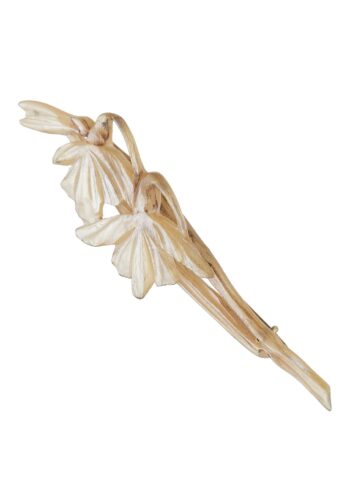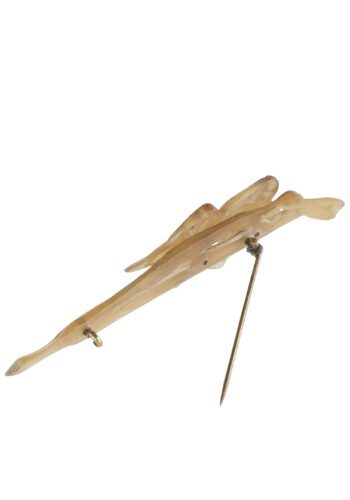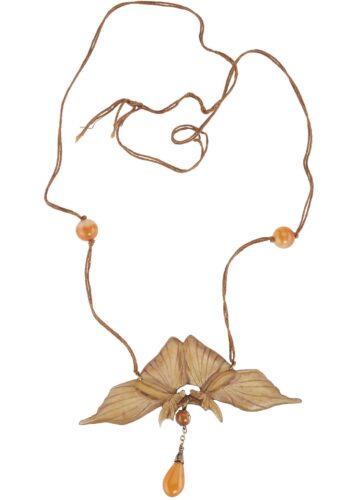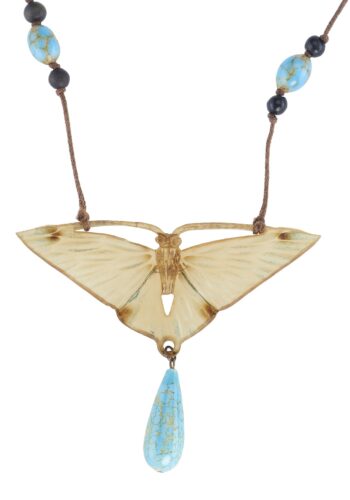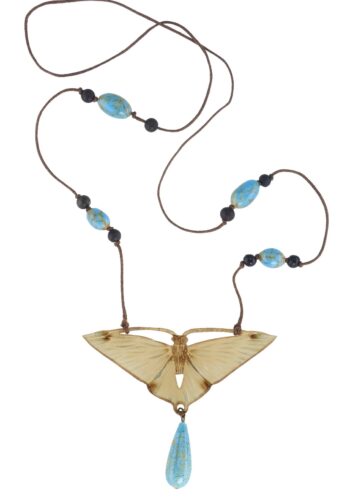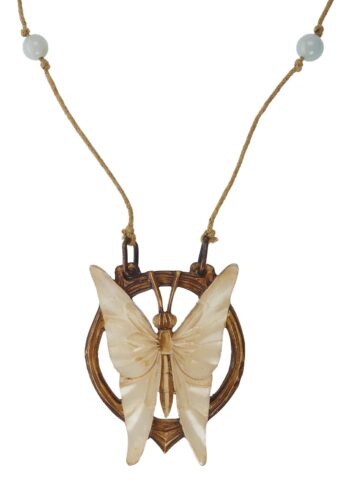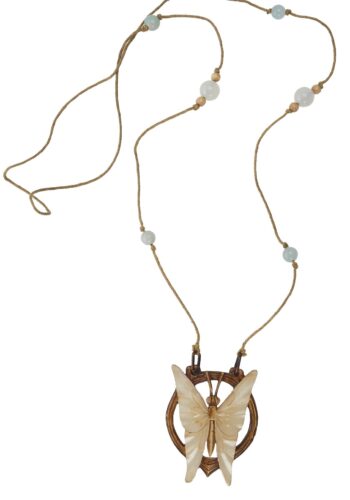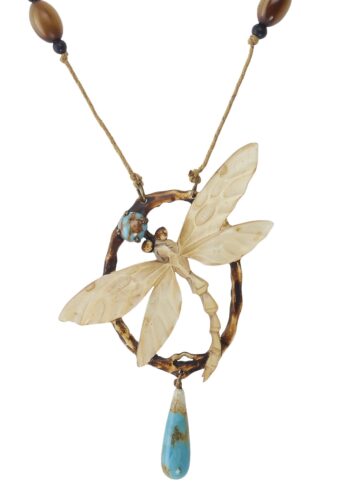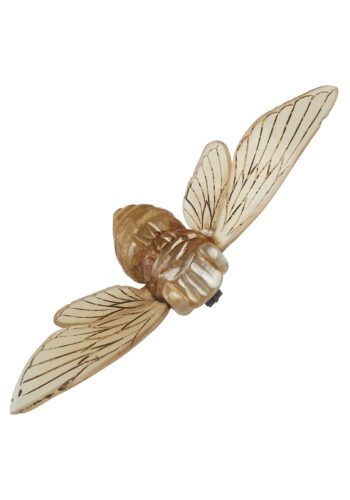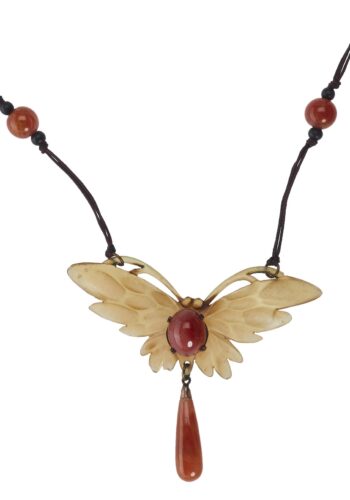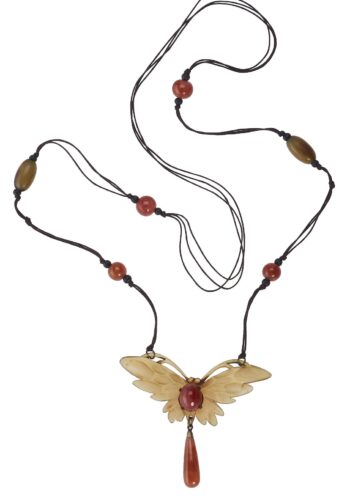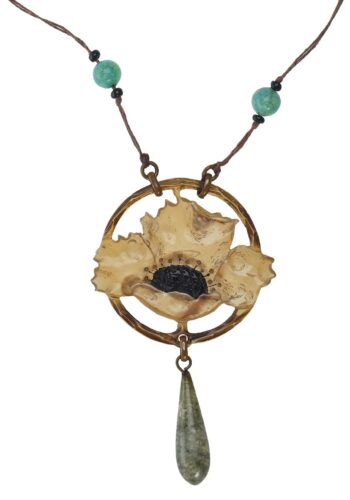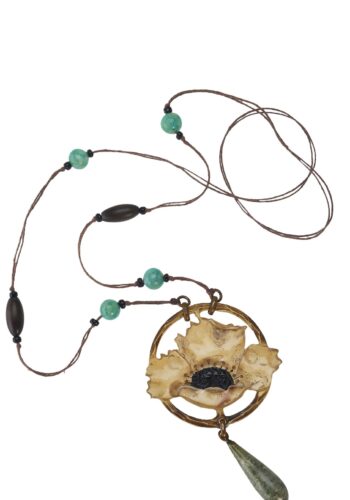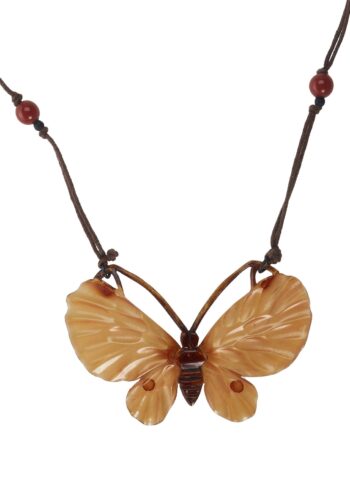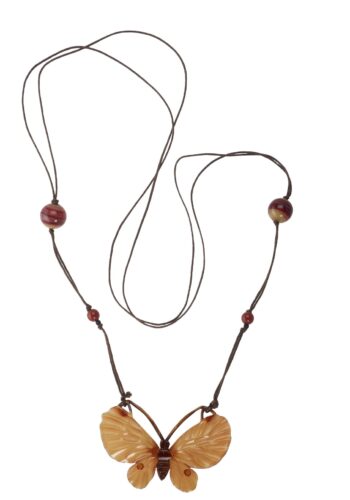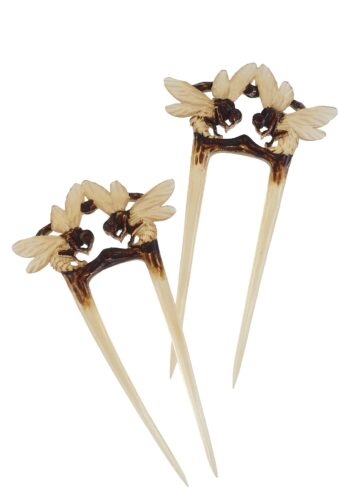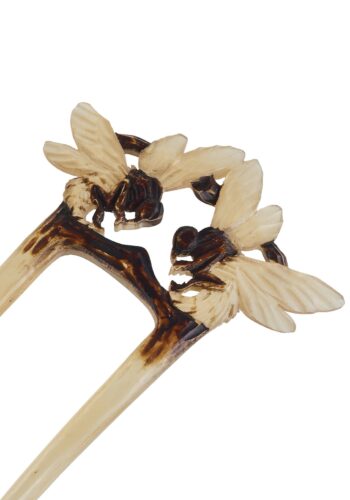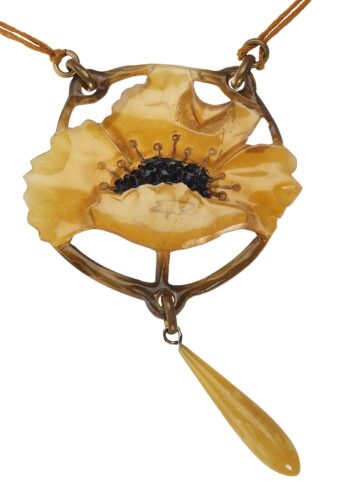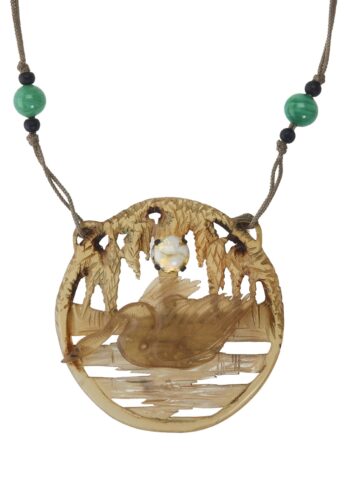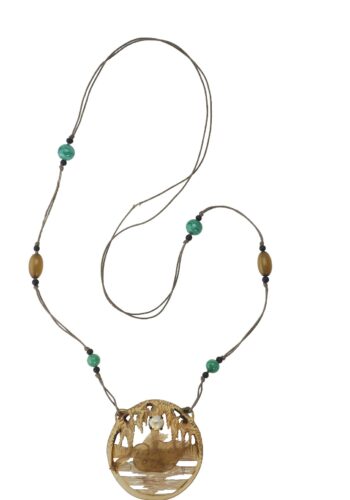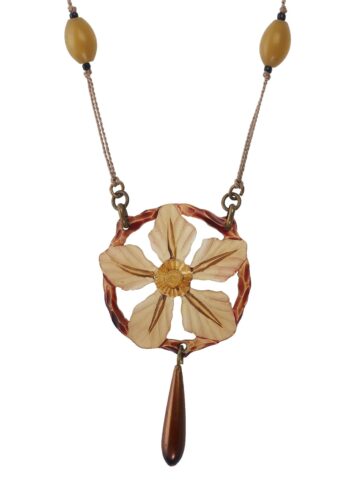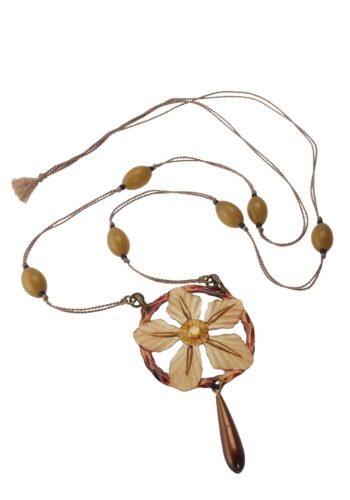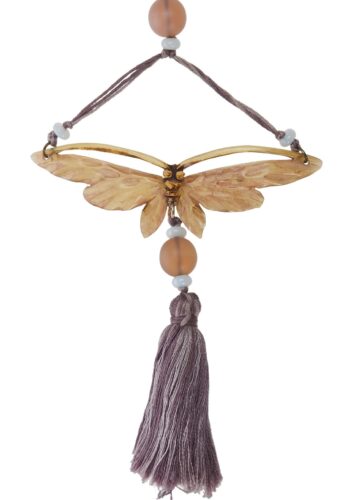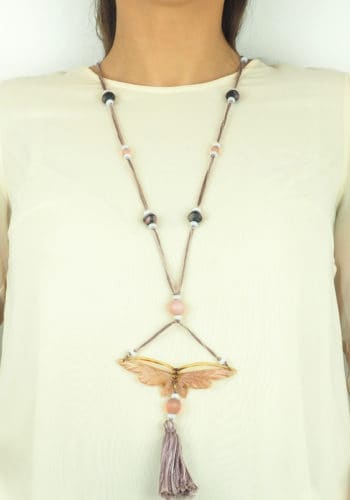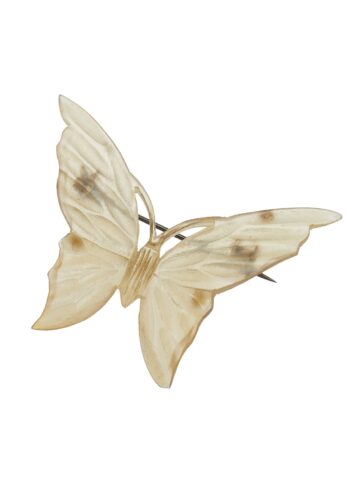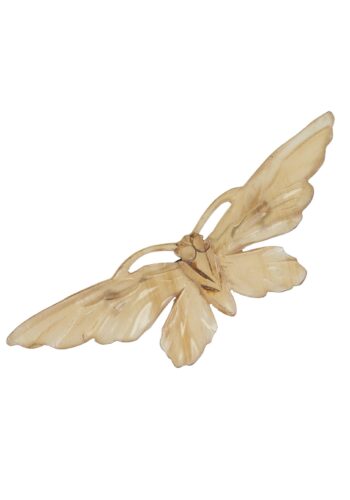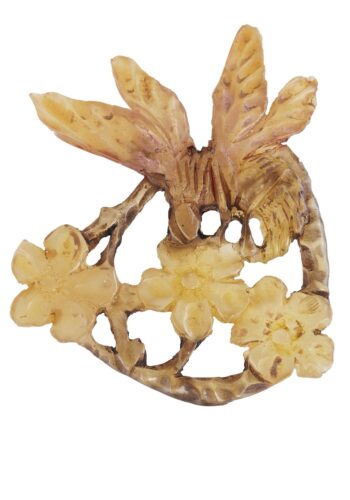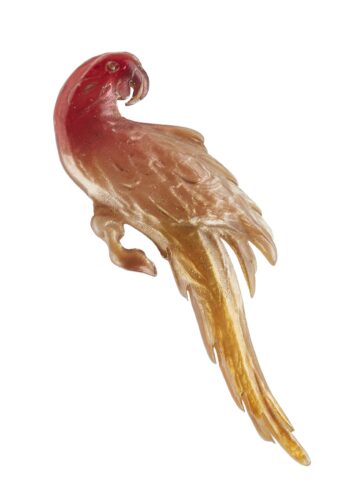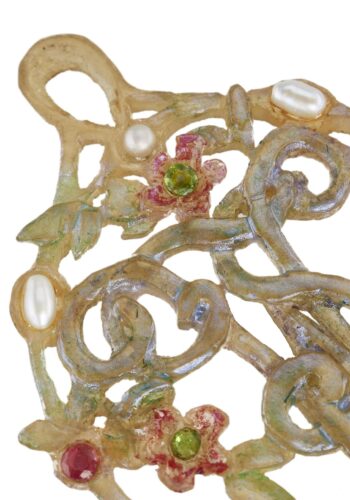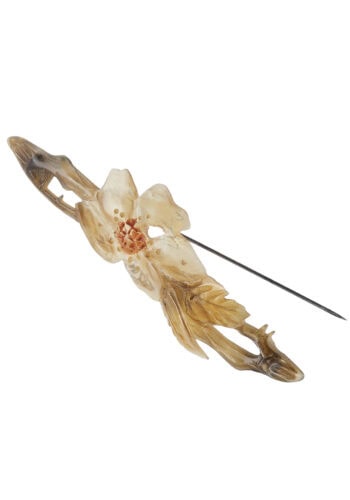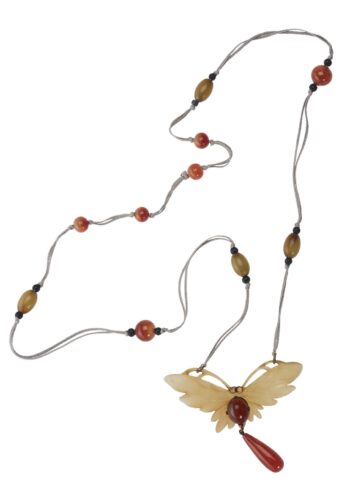
Horn jewellery
Antique horn jewellery is fascinatingly filigree and sensitive, but at the same time impressively powerful and expressive. They are legendary, alternative works of art from the great French jewellery history. We have the probably clearest representatives of antique jewellery from the art nouveau period in a collection that is unique in Europe and is available for purchase in our shop. Masterful works, which are inspired by nothing less than the wonders of nature. Immerse yourself in the world of French horn jewellery, from the hands of the most famous creators. Meet one of the most elaborate and profound types of the ancient jewellery arts. You buy horn jewellery at Antique Jewellery Berlin with absolute security and always with certificate, also online!
Buy antique horn jewellery online
It is a special luck to wear real horn jewellery of the old masters. Just to own it and to discover it again and again is pure passion and dedication to nature, as longtime customers and collectors of horn jewellery tell us. We can rightly claim to offer the widest selection of French horn jewellery on European soil (including islands) to interested buyers. Especially our collection of necklaces / sautoirs is unsurpassed! Since only a few passionate artists from France dedicated themselves to the production of horn jewellery between 1896 and 1936, the pieces still available on the market today are of small number. How many, or rather how few, pieces of jewellery of this kind are still freely available today in perfect original condition is easy to understand. The opportunities for acquisition will certainly dwindle drastically in the future! As art historians and antique jewellery dealers, we feel an unconditional obligation to nature, craftsmanship and the beauty of a thing. If you are looking for something unique, jewellery with an immortal charisma, then you should definitely also take a look at horn jewellery. The horn necklace as a representative overall work of art usually consists of a pendant with a long chain of silk ribbon or cord. The composition consists almost exclusively of organic material. Metal was either only used completely inconspicuously or for the stability inside. It is probably the absolute opposite of a diamond necklace - and yet no less exclusive and attractive. Above all, horn jewellery is individual. Because just like a shell, like a layer stone or like an opal, the material is always present in its unmistakable, naturally grown state. Other materials used are turquoise, agates (especially carnelian) and glass. They are either decorative and complementary components of the pendants or accurately set design elements on the chains / bands.
What does our range of antique horn jewellery include? We offer jewelry from different categories. These are exclusively genuine unique pieces from the most famous French horn jewellery workshops in the Art nouveau and Art déco creative phases. Here are some inspirations:
- Necklaces / Colliers / Sautoirs, consisting of a handcarved pendant and a usually very long chain of silk ribbon or corded textile ribbon,
- animal motifs in pendants and especially in brooches, some animals were originally represented in their natural size, e.g. dragonflies, cicadas, butterflies and many others,
- Hair combs made of horn, hand carved and hand painted, also here partly with animal motif as an appealing decoration element,
- Bracelets / bangles made of mostly dark horn, here from the size partly on the upper arm as an extravagant fashion accessory wearable.
Impressive attention to detail: Hand carved horn jewellery
Horn jewellery and Art Nouveau - an inseparable chapter in the history of antique jewellery. Although the production of horn jewellery continued until 1936, it is not Art Déco, but the original French Art Nouveau style that lives in horn jewellery. And one really has the amazing feeling that there is life in horn jewellery. The wealth of details, and above all their quality, is simply breathtaking! Never before have people devoted themselves so reverently and precisely to nature. Never before has the anatomy of insects been so accurately reproduced and the contours of plants and flowers so textbook-perfectly shaped by human hands. Never before, besides the obsession for details, was one additionally able to reveal mythological themes and meanings in a light-footed and carefree way. The craftsmanship and ideological creativity of the great horn jewellery creators is unsurpassed by any other form of jewellery production. Surely, to recognize the whole and succumb to its fascination requires the will and attention for it. Horn jewellery is made for confident people with inner greatness. For people who do not find the painting of the Mona Lisa "too small". For those who care about nature - i.e. the nature of people as such. Where our oldest ancestors come from, what horn jewellery shows has long been there.
Who were the artists, the visionaries, to whom generations of jewellery lovers could owe such fantastic creations? It's all about three big names: Georges Pierre, Elizabeth Bonté and René Lalique.
Lalique lived from 1860 to 1945 and was a visionary, an exceptionally educated man with a great sense for new arts and a clear mind for business matters. His own jewellery craft was mainly devoted to "other" materials. Not entirely, but often far from the usual jewellery of gold and precious stones, he found his passion first in carving and later, during the Art Deco period, in artistic glass design. It was he who recognized the potential of simple buffalo horn or goat's horn to be carved into stunning jewellery. His first works, involving precious metals, and precious stones and pearls, were not yet exposed to the power of the horn alone. In 1896 he exhibited a bracelet in the "Paris Salon", which won great applause and first-class reviews. Previously, it was only hair combs, buttons, umbrella handles and lorgnettes that represented the material. The attentive world now looked even more to France, especially to the most modern of all cities, the city of love and the arts. Paris, which at the time was one of the most influential metropolises in the world, determined what was hip in terms of fashion and style. The world took note of Lalique's design and was immediately eager for more. René Lalique and his comrades-in-arms, such as Lucien Gaillard, Piel Frères and Louis Aucoc, henceforth created innovative jewellery from carved horn. It was combined with gold, silver, copper, precious stones and pearls, depending on the designer's preference. Works by Lalique are unfortunately no longer available today. His deep bow to the horn as a material for jewellery, however, was groundbreaking for artists who subsequently built the great stage for the material. Completely without "regular" jewelry metals and precious stones. Lalique, the visionary, also turned to glass. A material from which no necklaces could be made, but exorbitantly beautiful works of art and accessories.
After the turn of the century in France, Elizabeth Bonté and Georges Pierre gave the horn undivided attention and love. Elizabeth Bonté, whose biographical data are not documented, was a studied and cosmopolitan artist and designer. She was born and grew up in the Burgundy region. She studied at the "School of Decorative Arts" in Paris, with a focus on the applied arts of Japan. She was also engaged in the sculpture of horn, leather stencils and wooden box carvings. As a young woman, she already opened her first own workshop at the beginning of the 20th century in Oyonnax, a town in the French Jura mountains. There the material horn had been used for comb production for decades, which ensured both a good supply of the raw material and a large number of talented and experienced craftsmen. It revolutionized the processing techniques of horn fundamentally. She passed on all her knowledge and skills in a future-oriented way within her own family, so that the processes are still known today.
There is no new production of horn jewellery, but similar to the Florentine pietra dura technique and the glass micromosaics of the Vatican, there are probably still people who are capable of the technique. Bonté used bull horns, buffalo horns and horns of mountain goats from the Jura. They were first cut into cross-sections and then heated with steam and rolled out manually into panels. On these panels one could draw the design of the planned piece of jewellery. At that time the plates were still dark and far from the translucent character of the finished work of art. The drawn design was then cut out by hand with a saw. In order to obtain the desired translucent quality in varying degrees of brightness, she soaked the raw material in hydrogen peroxide for about one day. She achieved more precise color results with different chemicals and various dyes. After polishing, ink was used to achieve the desired fine details of animal motifs or plants. Since Bonté was very familiar with the Japanese arts, she adapted them for the first time in European jewellery. She can therefore be considered the most important pioneer of "Japonism" in Europe. Art nouveau and Japonesque came together in the horn jewellery of Elisabeth Bonté and Georges Pierre and created a new art form. For the artists, horn had the positive quality of being able to represent three-dimensionally. Plants and petals, as well as insects and animals were modelled. What was much later considered "transformed nature" was a revolution at the beginning of the 20th century. It was not only the incredibly vivid depiction of nature in the form of animals, plants and even entire scenes that fascinated, but also the depth behind it. One can lose oneself in the perfectly worked motifs. The viewer takes in the created like a living moment.
You can discover some of Bonté's typical motifs, with their underlying meaning, and buy them for your collection:
- The Japanese chrysanthemum, the national flower of Japan, stands for perfection, durability and longevity, sometimes even immortality,
- The dragonfly, symbolic of courage and the resulting victory,
- The butterfly, symbol of the soul and its resurrection, lightness and spiritual weight in perfect balance,
- The cicada, in Japan symbol of the human soul and symbol of immortality, rebirth and long life.
Georges Pierre lived from 1873 to 1943 and was Bonté's biggest competitor - but over time he developed from an unloved competitor to a valued business partner and ally. As is well known, the two perfectionists shared a large workshop at some point in Oyonnax and operated it together until 1936. However, when the absolute marriage of horn jewellery took place around 1910, Bonté was the only "big brand" in the field. Officially Pierre was first mentioned as a hornist in 1926. But his works signed "GIP" definitely date from the period after 1910, when he and Bonté, as masterminds of horn jewellery, brought a multitude of innovative creations to life. He enjoyed the honor and recognition to which he was entitled in equal measure with Elizabeth Bonté. Georges Pierre also had a jewellery production in Bonneuil and a shop in Paris where he sold artistic jewellery, so-called Bijoux d'art. This was horn jewellery as well as glass jewellery and "regular" jewellery made of precious metals and gemstones.
You can also discover many of Pierre's typical motifs, with their mythological underlying meaning, and buy them for your collection:
- The poppy (the corn poppy), often rather negatively afflicted mythology, transience and self-lost, but it has an extremely attractive appearance,
- The cherry blossom, the Japanese symbol of female beauty - Pierre and Bonté shared a passion for this motif,
- Easter bell, flowering twig and other smaller plant motifs as brooch - Georges Pierre created more horn brooches than other artists.
Colliers and necklaces made of horn for an individual look
The long necklaces, which are also called sautoirs, were and are the most important pieces of jewellery when it comes to horn jewellery. They refine a look in an incomparable way. Their play with motifs and colors, with perfectly set accents, inspires both when worn and when viewed. There is probably no other piece of jewellery about which one can have such interesting conversations. The scenes from nature that fashion critics raved about in Parisian magazines over 100 years ago still seem so contemporary and fresh today.
Find your perfect Art nouveau horn jewellery at Antique Jewellery Berlin. We look forward to seeing you - discover all the details and the full effect of the jewellery in our shop in Berlin-Mitte. If you have any questions: please do not hesitate. We are always at your disposal!
Click to fold-
Ca. 1900 – Horn Brooch from Art nouveau, Paris, France, Motif “Snowdrops”
€ 890,00
Differential tax applies collectors items and antiques in accordance with German law §25a UStGFree Shipping -
Ca. 1900 – Horn Necklace with Cornelian-pearls Art nouveau France
€ 1.900,00
Differential tax applies collectors items and antiques in accordance with German law §25a UStGFree Shipping -
Ca. 1910 – Horn Necklace signed Georges Pierre Art nouveau France
€ 2.900,00
Differential tax applies collectors items and antiques in accordance with German law §25a UStGFree Shipping -
Ca. 1900 – Horn Necklace Butterfly Art nouveau France
€ 1.290,00
Differential tax applies collectors items and antiques in accordance with German law §25a UStGFree Shipping -
Ca. 1900 – Art nouveau Horn Necklace, “Dragonfly” by GIP Georges Pierre
€ 2.900,00
Differential tax applies collectors items and antiques in accordance with German law §25a UStGFree Shipping -
Ca. 1900 – Horn Brooch Motif Bee Art nouveau France
€ 790,00
Differential tax applies collectors items and antiques in accordance with German law §25a UStGFree Shipping -
Ca. 1900 – Horn Necklace Elizabeth Bonté Art nouveau France Jugendstil
€ 2.900,00
Differential tax applies collectors items and antiques in accordance with German law §25a UStGFree Shipping -
Ca. 1850 – Hair Comb & Tiara / Cut Steel
€ 1.290,00
Differential tax applies collectors items and antiques in accordance with German law §25a UStGFree Shipping -
Ca. 1900 – Horn Brooch by Georges Pierre, signed GP, from Art nouveau France Jugendstil Hornbrooch “Bee” Animal motif
€ 890,00
Differential tax applies collectors items and antiques in accordance with German law §25a UStGFree Shipping -
Ca. 1900 – Horn Necklace with Glass pearls Elizabeth Bonté Art nouveau France
€ 2.900,00
Differential tax applies collectors items and antiques in accordance with German law §25a UStGFree Shipping -
Ca. 1900 – Hand-carved Horn necklace with Glass pearls, “Poppy” signed by GIP Georges Pierre, Art nouveau France
€ 2.900,00
Differential tax applies collectors items and antiques in accordance with German law §25a UStGFree Shipping -
Ca. 1900 – Horn Necklace Butterfly Art nouveau France
€ 2.500,00
Differential tax applies collectors items and antiques in accordance with German law §25a UStGFree Shipping -
Ca. 1900 – 1 Pair Horn Combs Motif Bees Art nouveau France
€ 1.490,00
Differential tax applies collectors items and antiques in accordance with German law §25a UStGFree Shipping -
Ca. 1900 – Horn Necklace signed Georges Pierre Art nouveau France
€ 2.900,00
Differential tax applies collectors items and antiques in accordance with German law §25a UStGFree Shipping -
Ca. 1900 – Horn Necklace signed Elizabeth Bonté, French Art nouveau
€ 3.500,00
Differential tax applies collectors items and antiques in accordance with German law §25a UStGFree Shipping -
Ca. 1900 – Horn Necklace Motif “Flower” from Art nouveau France, French Jugendstil Horn jewellery
€ 2.290,00
Differential tax applies collectors items and antiques in accordance with German law §25a UStGFree Shipping -
Ca. 1900 – Horn Necklace with Glass-pearls Art nouveau France
€ 2.500,00
Differential tax applies collectors items and antiques in accordance with German law §25a UStGFree Shipping -
Ca. 1900 – Horn Brooch Butterfly Art nouveau Paris France Animaljewellery
€ 320,00
Differential tax applies collectors items and antiques in accordance with German law §25a UStGFree Shipping -
Ca. 1900 – Art nouveau Horn Brooch “Butterfly”, from Paris, France
€ 350,00
Differential tax applies collectors items and antiques in accordance with German law §25a UStGFree Shipping -
Ca. 1900 – Horn Brooch Motif “A bee pollinates a blossom” Art nouveau, Paris, France
€ 1.290,00
Differential tax applies collectors items and antiques in accordance with German law §25a UStGFree Shipping -
Ca. 1910 – Horn Brooch from Art nouveau, Paris, France, “Parrot” hand-carved & hand-painted
€ 890,00
Differential tax applies collectors items and antiques in accordance with German law §25a UStGFree Shipping -
Ca. 1900 – Art nouveau Horn Pendant with Glass stones & Pearls, from Paris, France
€ 890,00
Differential tax applies collectors items and antiques in accordance with German law §25a UStGFree Shipping -
Ca. 1900 – Horn Brooch Motif “Flowering twig”, signed by Georges Pierre GIP in Art nouveau France Jugendstil
€ 490,00
Differential tax applies collectors items and antiques in accordance with German law §25a UStGFree Shipping -
Ca. 1900 – Hand-carved Horn necklace with Glass pearls, “Butterfly” signed by Elizabeth Bonté, Art nouveau France
€ 2.900,00
Differential tax applies collectors items and antiques in accordance with German law §25a UStGFree Shipping


